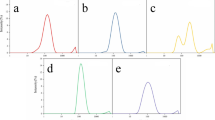Abstract
An investigation of liposomes comprised of 1,2-dimyristoyl-sn-glycero-3-phosphocholine (DMPC) or 1,2-distearoyl-sn-glycero-3-phosphocholine (DSPC) lipids with cholesterol and zinc phthalocyanine (ZnPC) revealed that several fundamental liposome properties are influenced by composition and by lipid-specific features. DMPC and DSPC liposomes were synthesized, and their compositional changes, encapsulation capacities, morphologies, and release properties were evaluated. In this research, liposome degradation, lysis, and content release were initiated by photolysis, i.e., rupture induced by exposure to light. A controlled release mechanism was created through the introduction of photosensitizers (i.e., ZnPC) embedded within the cholesterol-stabilized liposome membrane. The light wavelength and light exposure time accelerated photodegradation properties of DMPC liposomes compared to DSPC liposomes, which exhibited a slower release rate. Morphological changes in the liposomes were strongly influenced by light wavelength and light exposure time. For both the DMPC and DSPC liposomes, visible light with wavelengths in the red end of the spectrum and broad spectrum ambient lighting (400–700 nm) were more effective for lysis than UV-A light (365 nm). Heating liposomes to 100 °C decreased the stability of liposomes compared to liposomes kept at room temperatures. In addition, the optimal lipid-to-cholesterol-to-photoactivator ratio that produced the most stable liposomes was determined.













Similar content being viewed by others
References
Ozato, K., Ziegler, H., & Henney, C. (1978). Journal of Immunology, 121, 1376–1382.
Sessa, G., & Weissman, G. (1970). Journal of Biological Chemistry, 245, 3295–3301.
Chaize, B., Colletier, J. P., Winterhalter, M., & Fournier, D. (2004). Artificial Cells, Blood Substitutes, and Immobilization Biotechnology, 32, 67–75.
Schreier, H., & Bouwstra, J. (1994). Journal of Controlled Release, 30, 1–15.
Bangham, A. D., & Horne, R. W. (1964). Journal of Molecular Biology, 8, 660–668.
Wichelecki, D. J., McNew, T. M., Aygun, A., Torrey, K., & Stephenson, L. D. (2011). Applied Biochemistry and Biotechnology, 165(2), 548–558.
Jeong, J. M., Chung, Y. C., & Hwang, J. H. (2002). Journal of Biotechnology, 94, 255–263.
Wan, Y., Angleson, J. K., & Kutateladze, A. G. (2002). Journal of the American Chemical Society, 124, 5610–5611.
Cheong, I., Huang, X., Bettegowda, C., Diaz, L. A., Jr., Kinzler, K. W., Zhou, S., et al. (2006). Science, 314, 1308–1311.
Bisby, R. H., Mead, C., & Morgan, C. G. (1999). FEBS Letters, 463, 165–168.
Anderson, V. C., & Thompson, D. H. (1992). Biochimica et Biophysica Acta, 1109, 33–42.
Mohammed, A. R., Weston, N., Coombes, A. G. A., Fitzgerald, M., & Perrie, Y. (2004). International Journal of Pharmaceutics, 285(1–2), 23–34.
Sulkowski, W. W., Pentak, D., Novak, K., & Sulkowska, A. (2005). J. of Molecular Structure, 744–747, 737–747.
Epand, R. M., Epand, R. F., & Maekawa, S. (2003). Chemistry and Physics of Lipids, 122, 33–39.
Nunes, S. M. T., Sguilla, F. S., & Tedesco, A. C. (2004). Brazilian Journal of Medical and Biological Research, 37, 273–284.
Switzer, R., & Garrity, L. (1999). Experimental biochemistry: theory and exercises in fundamental methods (pp. 123–134). New York: Freeman and Company.
Yousefi, A., Esmaeili, F., Rahimian, S., Atyabi, F., & Dinarvand, R. (2009). Scientia Pharmaceutica, 77, 453–464.
Hubert, D. H. W., Jung, M., Frederik, P. M., Bomans, P. H. H., Meuldijk, J., & German, A. L. (2000). Advanced Materials, 12, 1286–1290.
Gregoriadis, G., & Davis, C. (1979). Biochemical and Biophysical Research Communications, 89, 1287–1293.
Senior, J., & Gregoriadis, G. (1982). FEBS Letters, 145, 109–114.
Anderson, S. M., & Krinsky, N. I. (1973). Photochemistry and Photobiology, 18, 403–408.
Hupfeld, S., Holsæter, A. M., Skar, M., Frantzen, C. B., & Brandl, M. (2006). Journal of Nanoscience and Nanotechnology, 6, 1–7.
Benkhoff, J., Dietliker, K., Powell, K., Jung, T., Studer, K., & Sitzmann, E. V. (2007). JCT Coatings Technology, 4, 40–46.
Acknowledgments
We gratefully acknowledge the financial support from the US Army Corps of Engineer (USACE). This work was all done at Engineer Research and Development Center—Construction Engineering Research Laboratory (ERDC-CERL) and was funded by USACE 6.1 funds. The authors would also like to thank Ms. B. Mehnert for aid in editing the paper.
Author information
Authors and Affiliations
Corresponding author
Rights and permissions
About this article
Cite this article
Aygun, A., Torrey, K., Kumar, A. et al. Investigation of Factors Affecting Controlled Release from Photosensitive DMPC and DSPC Liposomes. Appl Biochem Biotechnol 167, 743–757 (2012). https://doi.org/10.1007/s12010-012-9724-6
Received:
Accepted:
Published:
Issue Date:
DOI: https://doi.org/10.1007/s12010-012-9724-6




